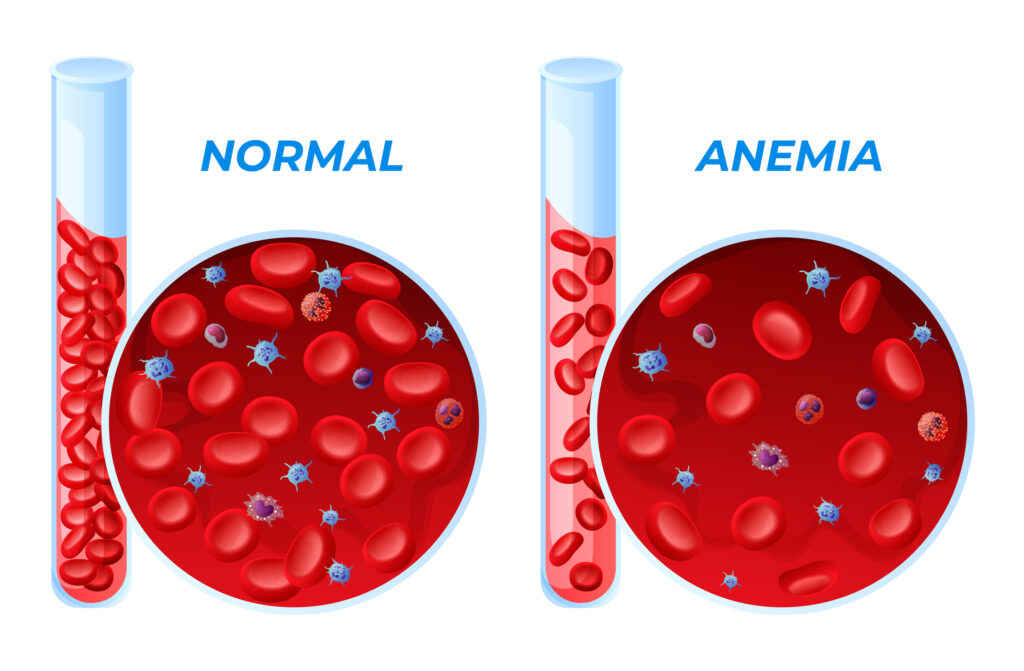What is Anaemia?
Anemia means that you have fewer red blood cells than normal,or have less hemoglobin than normal in each red blood cell. In either case, a reduced amount of oxygen is carried around in the bloodstream.
What causes anemia?
The most common cause of anemia in Pakistan is iron deficiency. If you are taking a balanced diet, it contains sufficient iron to fulfill your iron needs. Other important causes in Pakistan are thalassemia, pregnancy, unexplained bleeding anywhere in the body, heavy periods, and long-term illness.
What are the signs and symptoms of anemia?
- Common symptoms are due to the reduced amount of oxygen in the body. These include tiredness, having little energy, feeling faint, and becoming easily breathless.
- Less common symptoms include headaches, a 'thumping heart' (palpitations), altered taste, feverish feeling, and ringing in the ears (tinnitus).
- You may look pale.
How can you diagnose anemia?
Your doctor will take your complete medical and family history and perform a complete physical examination to diagnose anemia. After that, a simple full blood count with a peripheral smear can measure the amount of hemoglobin in your blood, count the number and determine the shape and size of red blood cells. This can tell you to what extent you are anemic, but it is crucial to determine the underlying cause if not evident.
When should you see a doctor?
- Persistent fatigue, breathlessness, rapid heart rate, pale skin, or any other symptoms of anemia; seek emergency care for any trouble breathing or change in your heartbeat.
- Inadequate diet
- Very heavy menstrual periods
- Symptoms of an ulcer, hemorrhoids, bloody stools.
- Hereditary anemia runs in your family, and you would like genetic counseling before having a child.
انیمیا
انیمیا کیا ہے؟
انیمیا کا مطلب ہے خون کی کمی۔ یعنی کہ آپ کے جسم میں خون کے سرخ خلیات یا پھر ان سرخ خونی خلیوں میں ہیموگلوبن کی مقدار معمول سے کم ہے۔ دونوں ہی صورتحال میں خون کے زریعے پہنچنے والی آکسیجن کی فراہمی کم ہو جاتی ہے۔
انیمیا کی کیا وجوہات ہیں؟
پاکستان میں انیمیا کی سب سے بڑی وجہ آئرن کی کمی ہے۔ اگر اپ متوازن غزا لے رہے ہیں تو یہ آئرن کی ضرورت پوری کرنے کے لیے کافی ہے۔ پاکستان میں خون کی کمی کی دیگر وجوہات میں تھیلیسیمیا، حمل، کسی بھی وجہ سے خون ضائع ہونا، ماہواری میں زیادہ خون کا بہاؤ اور طویل مدتی بیماری شامل ہیں.
انیمیا کی کیا علامات ہیں؟
انیما کی صورت میں ظاہر ہونے والی علامات میں سے بیشتر آکسیجن کی کمی کی وجہ سے ظاہر ہوتی ہیں۔ ان وجوہات میں تھکاوٹ، توانائی کی کمی، بےہوش ہونا اور سانس پھولنا شامل ہے۔
معمول کی علامات کے علاوہ اینیمیا کی وجوہات سر درد، دل کی دھڑکن میں تیزی، زبان کا ذائقہ تبدیل ہونا، متواتر ہلکا بخار ہونا اور کان میں گھنٹیاں بجنا ہو سکتی ہیں۔
انیمیا کیسے تشخیص ہوتا ہے؟
انیمیا کی تشخیص کے لئے معالج کو آپکی مکمل خاندانی طبّی کوائف اور طبی معاینه درکار ہوگا۔ اس کے ساتھ خون کے ٹیسٹ کے زریعے هموگلوبین کی مقدار مع سرخ خلیوں کی گنتی اور شکل کی جانچ پرتال کی جاتی ہے ۔ اس تشخیصی مرحلے سے آپ کو معلوم ہوسکے گا کہ آپ میں خون کی کمی کس حد تک ہے اور اس کی بنیادی وجہ کیا ہے۔
ڈاکٹر سے کب ملیں؟
مستقل تھکاوٹ، سانس لینے میں دشواری، جلد کی پیلاہٹ،یا خون کی کمی کی کسی اور وجہ کے ظاہر ہونے کی صورت میں معالج سے رجوع کرنا چاہیے۔ سانس کے روکنے یا دھڑکن کی تبدیلی پر ہنگامی طبعی مدد حاصل کرنا ضروری ہے۔
غذائی قلّت، بھاری ماہواری، السر، بواسیر یا پاخانے میں خون آنے کی صورت میں فوراً معالج سے رابطہ کریں۔
موروثی خون کی کمی کی بیماری نسلوں میں منتقل ہو سکتی ہے لہٰذا بچے کی پیداش سے پہلے جینیاتی مشاورت ضرور حاصل کریں۔
Doctors to consult (General Haematology):
Dr. Mubashir Khan Razzaq, Dr. Nauman Khan
Note: Click the Doctor's name to make an appointment.
Reference:
https://www.mayoclinic.org/diseases-conditions/anemia/diagnosis-treatment/drc-20351366
https://www.webmd.com/a-to-z-guides/understanding-anemia-symptoms
https://patient.info/allergies-blood-immune/anaemia-leaflet/iron-deficiency-anaemia#nav-2

